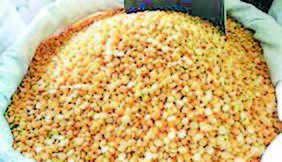A high influx of fresh chickpeas in the market resulted in a price decline, according to Mandalay wholesale depot figures.
At present, chickpeas produced from Thetaw, Wundwin, Kume, Sagaing and Monywa areas flow into the Mandalay market. Subsequently, the prices continued declining. Moreover, the demand for domestic millers also influenced the market.
The prices peaked at K287,000- K315,000 per viss on 12 January as the demand by oil millers and growers who store the seeds for planting in the following season outstripped supply in the market. Then, the prices dipped to K225,000-K248,000 per viss on 4 April.
Chickpeas are commonly cultivated in October-November and harvested in January-April. They are primarily grown in Bago, Ayeyawady, Sagaing, Magway and Mandalay regions.
The country primarily cultivates paddy, corn, cotton, sugarcane, various pulses and beans. Its second-largest production is pulses and beans, accounting for 33 per cent of agro-products and covering 20 per cent of growing acres. Among them, black beans, pigeon peas and green grams constitute 72 per cent of bean acreage. Other beans, including peanuts, chickpeas, soybeans, black-eyed beans, butter beans and rice beans, are also grown in the country.
Myanmar’s agriculture sector is the backbone of the country’s economy, and it contributes significantly to the Gross Domestic Product (GDP).
Myanmar ships chickpeas to foreign markets beyond self-sufficiency. More than 4,200 kilogrammes worth US$4.159 million were exported to foreign trade partners in the financial year 2023-2024 beginning 1 April, according to the Ministry of Commerce’s statistics.
Myanmar exported over 18,000 kilogrammes worth $13.139 million in the FY 2022-2023. — NN/EM



